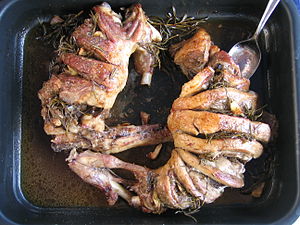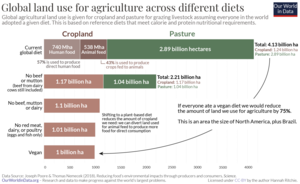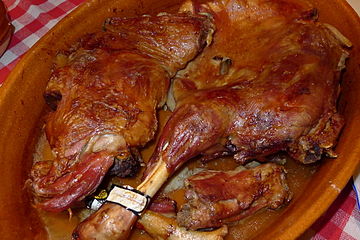Lamb and mutton/ja: Difference between revisions
No edit summary |
|||
| Line 20: | Line 20: | ||
[[File:Abbacchio Pasquale.jpg|thumb|''[[Abbacchio/ja|アバッキオ]]''は[[:en:central Italy|イタリア中部]]で[[:en:Easter in Italy|復活祭]]や[[:en:Christmas in Italy|クリスマス]]の料理として食される。これは[[:en:European Union|欧州連合]]により[[:en:Geographical indications and traditional specialities in the European Union#Protected geographical indication (PGI)|PGI]]マークで保護されている製品である。]] | [[File:Abbacchio Pasquale.jpg|thumb|''[[Abbacchio/ja|アバッキオ]]''は[[:en:central Italy|イタリア中部]]で[[:en:Easter in Italy|復活祭]]や[[:en:Christmas in Italy|クリスマス]]の料理として食される。これは[[:en:European Union|欧州連合]]により[[:en:Geographical indications and traditional specialities in the European Union#Protected geographical indication (PGI)|PGI]]マークで保護されている製品である。]] | ||
[[:en:Romanesco dialect|ロマネスコ方言]]において、まだ授乳中もしくは離乳直後の子羊は''[[abbacchio/ja|アバッキオ]]''と呼ばれ、すでに2回毛刈りされたほぼ1歳の子羊は''agnello''({{literally|ラム}})と呼ばれる。この区別はロマネスコ方言にのみ存在する。''アバッキオ''は[[:en:central Italy|イタリア中部]]全域で[[:en:Easter in Italy|復活祭]]や[[:en:Christmas in Italy|クリスマス]]の料理として食される。これは[[:en:European Union|欧州連合]]により[[:en:Geographical indications and traditional specialities in the European Union#Protected geographical indication (PGI)|PGI]]マークで保護された製品である。 | |||
<div lang="en" dir="ltr" class="mw-content-ltr"> | <div lang="en" dir="ltr" class="mw-content-ltr"> | ||
Revision as of 15:09, 25 August 2025


ラム肉とマトン、総称して羊肉(またはシープミート)は、世界で最も一般的な肉の一つであり、家羊 Ovis aries から得られ、一般的に、生後1年以内の羊から得られるラム、2年目の羊から得られるホゲット、それ以上の年齢の羊から得られるマトンに分けられる。一般的に、「ホゲット」と「羊肉」という語は、ノルウェー、ニュージーランド、南アフリカ、スコットランド、オーストラリア以外の消費者には用いられない。ホゲットは、特にイングランド北部(ランカシャーおよびヨークシャー)でより一般的になりつつあり、希少品種や有機農業と関連していることが多い。
南アジア料理やカリブ料理において、「マトン」はしばしばヤギ肉を意味する。様々な時代や地域において、「マトン」や「ゴートマトン」がヤギ肉を意味する場合があった。
ラム肉は3種類の中で最も高価であり、近年では羊肉は「ラム」としてのみ販売されることが増え、上述の区別が曖昧にされることもある。より強い風味を持つマトンは、多くの地域で入手が困難になっており、イギリスのMutton Renaissance Campaignによる普及活動にもかかわらず、その状況は続いている。オーストラリアでは、肉用に飼育されたラムを指す語としてプライムラムがよく用いられる。フランス語、スペイン語、イタリア語などの言語では、羊肉を年齢や場合によっては性別や飼料に応じて同様、もしくはさらに詳細に区別しており、例えばスペイン語のlechazoは母乳で育てられた(離乳していない)子羊の肉を指す。
分類と命名

ラム、ホゲット、マトンの定義は国によって大きく異なる。若いラムは小さく、肉質が柔らかい。マトンは2年以上の羊の肉であり、肉質が硬い。一般的に、色が濃いほど動物が年を取っている。
イギリス、オーストラリア、ニュージーランド
- ラム
- 生後1年未満の若い羊。2019年7月1日から、オーストラリアにおける定義は「(a) 12か月未満である、または (b) 永久切歯が摩耗していないヒツジ」とされた。この新しい定義により、オーストラリアの農家は「ラム」と呼べる期間を1か月延長できるようになった。これは2018年のニュージーランドにおける定義変更に続くものである。イギリスでは依然として「永久切歯が0本」という定義である。永久切歯が摩耗している(in wear)とは、それが隣接する乳歯より突き出している場合を指す。
- ホゲット
- 永久切歯が2本以下で摩耗している羊(性別を問わない)。この語はその羊の肉を指すのにも用いられる。イギリスでは11~24か月齢の羊を指し、オーストラリアの精肉業者は13~24か月齢の羊に用いる。農業や専門精肉業者の間では依然として一般的だが、イギリス、オーストラリア、ニュージーランドのスーパーマーケットでは、2年未満の羊の肉はすべて「ラム」と呼ばれる傾向があり、ホゲットという語は稀である。
- マトン
- 永久切歯が2本以上摩耗している雌(雌羊)または去勢された雄(去勢羊)の肉。
イタリア

ロマネスコ方言において、まだ授乳中もしくは離乳直後の子羊はアバッキオと呼ばれ、すでに2回毛刈りされたほぼ1歳の子羊はagnello(lit. 'ラム')と呼ばれる。この区別はロマネスコ方言にのみ存在する。アバッキオはイタリア中部全域で復活祭やクリスマスの料理として食される。これは欧州連合によりPGIマークで保護された製品である。
Throughout central Italy, including Sardinia, pastoralism was the main source of meat. Since ancient times, abbacchio has been one of the staple foods of the Lazio region, especially for rural communities, whose consumption at the table was considerable. The tradition of consuming abbacchio spread in ancient times where mainly adult sheep were slaughtered. The slaughter of abbacchio was forbidden except during the Easter and Christmas periods, and until June. Over the centuries, given the importance of the food, around 100 recipes for preparing lamb have been developed in Lazio. Given the importance of abbacchio in social life, historical events dedicated to abbacchio are still organized in the Lazio region today, i.e. sagre, country festivals and popular events. In ancient times, sheep was eaten during work in the countryside, while abbacchio was consumed only during the Easter holidays.
South Asia

The term "mutton" is applied to goat meat in most countries of South Asia, and the goat population has been rising. For example, mutton curry is always made from goat meat. It is estimated that over a third of the goat population is slaughtered every year and sold as mutton. The domestic sheep population in India and the Indian subcontinent has been in decline for over 40 years and has survived at marginal levels in mountainous regions, based on wild-sheep breeds, and mainly for wool production.
However, in some Indian states(such as Andhra Pradesh and Telangana), sheep meat is also popular.
United States
In the early 1900s, mutton was widely consumed in the United States, but mutton consumption has declined since World War II. As of 2010, most sheep meat in the United States comes from animals in between 12 and 14 months old, and is called "lamb"; the term "hogget" is not used. USDA grades for lamb are only partly a function of the animal's age. Animals up to 20 months old may meet the quality of the "USDA prime" grade depending on other factors, while "USDA choice" lamb can be of any age. "Spring lamb" is defined by the USDA as having been slaughtered between March and October.
Other types

- Suckling lamb or milk-fed lamb
- Meat from an unweaned lamb, typically 4–6 weeks old and weighing 5.5–8 kg; this is typically unavailable in countries such as the United States and the United Kingdom. The flavour and texture of milk-fed lamb when grilled (such as the small lamb cutlets known as chuletillas in Spain) or roasted (lechazo asado or cordero lechal asado) is generally thought to be finer than that of older lamb, and fetches higher prices The areas in northern Spain where this can be found include Asturias, Cantabria, Castile and León, and La Rioja. Milk-fed lambs are especially prized for Easter in Greece, when they are roasted on a spit.
- Young lamb
- A milk-fed lamb between six and eight weeks old
- Spring lamb
- A lamb, usually three to five months old, born in late winter or early spring and sold usually before 1 July (in the northern hemisphere).
- Sucker lambs
- A term used in Australia — includes young milk-fed lambs, as well as slightly older lambs up to about seven months of age which are also still dependent on their mothers for milk. Carcasses from these lambs usually weigh between 14 and 30 kg. Older weaned lambs which have not yet matured to become mutton are known as old-season lambs.
- Yearling lamb
- a young sheep between 12 and 24 months old
- Saltbush mutton
- a term used in Australia for the meat of mature Merinos which have been allowed to graze on atriplex plants
- Salt marsh lamb
- (Also known as 'saltmarsh lamb' or by its French name, agneau de pré-salé) The meat of sheep which graze on salt marsh in coastal estuaries that are washed by the tides and support a range of salt-tolerant grasses and herbs, such as samphire, sparta grass, sorrel and sea lavender. Depending on where the salt marsh is located, the nature of the plants may be subtly different. Salt marsh lamb has long been appreciated in France and is growing in popularity in the United Kingdom. Places where salt marsh lamb are reared in the UK include Harlech and the Gower Peninsula in Wales, the Somerset Levels, Morecambe Bay and the Solway Firth.
- Saltgrass lamb
- A type of lamb exclusive to Flinders Island (Tasmania). The pastures on the island have a relatively high salt content, leading to a flavor and texture similar to saltmarsh lamb.
Butchery and cookery
-
Lechazo asado (roast lamb) is a typical dish from the province of Valladolid and other Castilian provinces in Spain.
-
Chuletillas of milk-fed lamb in Asturias
-
Cooked boneless leg of lamb with potatoes and carrots, Italy
-
Lamb shanks of a young lamb
-
Mutton rogan josh from India
The meat of a lamb is taken from the animal between one month and one year old, with a carcass weight of between 5.5 and 30 kg (12 and 66 lb). This meat generally is more tender than that from older sheep and appears more often on tables in some Western countries. Hogget and mutton have a stronger flavour than lamb because they contain a higher concentration of species-characteristic fatty acids and are preferred by some. Mutton and hogget also tend to be tougher than lamb (because of connective tissue maturation) and are therefore better suited to casserole-style cooking, as in Lancashire hotpot, for example.
Lamb is often sorted into three kinds of meat: forequarter, loin, and hindquarter. The forequarter includes the neck, shoulder, front legs, and the ribs up to the shoulder blade. The hindquarter includes the rear legs and hip. The loin includes the ribs between the two.
Lamb chops are cut from the rib, loin, and shoulder areas. The rib chops include a rib bone; the loin chops include only a chine bone. Shoulder chops are usually considered inferior to loin chops; both kinds of chops are usually grilled. Breast of lamb (baby chops) can be cooked in an oven.
Leg of lamb is a whole leg; saddle of lamb is the two loins with the hip. Leg and saddle are usually roasted, though the leg is sometimes boiled.
Forequarter meat of sheep, as of other mammals, includes more connective tissue than some other cuts, and, if not from a young lamb, is best cooked slowly using either a moist method, such as braising or stewing, or by slow roasting or American barbecuing. It is, in some countries, sold already chopped or diced.
Lamb shank definitions vary, but generally include:
- a cut from the arm of shoulder, containing leg bone and part of round shoulder bone, and covered by a thin layer of fat and fell (a thin, paper-like covering).
- a cut from the upper part of the leg.
Mutton barbeque is a tradition in Western Kentucky. The area was strong in the wool trade, which gave them plenty of older sheep that needed to be put to use.
Thin strips of fatty mutton can be cut into a substitute for bacon called macon.
Lamb tongue is popular in Middle Eastern cuisine both as a cold cut and in preparations like stews.
Cuts
UK, Canada, and other Commonwealth countries

Approximate zones of the usual UK cuts of lamb:
US and Ireland
New Zealand
- Forequarter
- Neck – neck chops
- Shoulder – shoulder chops, shoulder roast (usually boned and rolled)
- Rib-eye
- Breast
- Knuckle
- Loin
- Rib-loin – racks, frenched cutlets, spare ribs
- Mid-loin – striploin (backstrap), loin chops
- Tenderloin
- Flap
- Full leg – leg roast (may be boned and rolled), leg chops. A short-cut leg is a full leg without the chump; a carvery leg is a short-cut leg without the thick flank
- Chump (rump) – chump chops, rump steak
- Thick flank (knuckle) – schnitzel
- Topside & silverside – steaks
- Shank
Production and consumption figures
Sheep meat consumption
According to the OECD-FAO Agricultural Outlook for 2016, the top consumers of sheep meat in 2015 were as follows: EU countries are not individually surveyed in this list. Among EU nations, Greece is the per capita leader in consumption at 12.3 kg, while the UK's annual per capita lamb consumption is 4.7 kg. Outside of the OECD, the largest per capita consumer overall is Mongolia, with 45.1 kg.
Sheep meat production
The table below gives a sample of producing nations, but many other significant producers in the 50–120 kt range are not given.
| 2008 | 2009 | 2010 | 2011 | 2012 | |
|---|---|---|---|---|---|
World |
8,415 | 8,354 | 8,229 | 8,348 | 8,470 |
| 179 | 197 | 205 | 253 | 261 | |
| 660 | 635 | 556 | 513 | 556 | |
| 79 | 80 | 82 | 84 | 85 | |
| 1,978 | 2,044 | 2,070 | 2,050 | 2,080 | |
| 130 | 126 | 119 | 115 | 114 | |
| 38 | 38 | 38 | 39 | 36 | |
| 91 | 90 | 90 | 90 | 90 | |
| 275 | 286 | 289 | 293 | 296 | |
| 113 | 128 | 113 | 113 | 113 | |
| 170 | 114 | 90 | 104 | 126 | |
| 110 | 116 | 123 | 128 | 128 | |
| 598 | 478 | 471 | 465 | 448 | |
| 145 | 149 | 171 | 172 | 174 | |
| 156 | 164 | 167 | 171 | 173 | |
| 278 | 262 | 240 | 253 | 272 | |
| 124 | 128 | 130 | 130 | 133 | |
| 326 | 307 | 277 | 289 | 275 | |
| 81 | 80 | 76 | 69 | 72 | |
| Source: Helgi Library, World Bank, FAOSTAT | |||||
Dishes


Meat from sheep features prominently in the cuisines of several Mediterranean cultures including Greece, Croatia, Turkey, North Africa, Jordan, and the Middle East, as well as in the cuisines of Iran and Afghanistan. In Greece, for example, it is an integral component of many meals and of religious feasts such as Easter, like avgolemono and magiritsa. It is also popular in the Basque culture, both in the Basque country of Europe and in shepherding parts of the Western United States (where shepherds of Basque descent have been active since the 1850s). In the United States, the Navajo have incorporated mutton and lamb into their traditional cuisine since the introduction of sheep by Spanish explorers and settlers in the 17th century, replacing wild turkey and venison and creating a pastoral culture. In Northern Europe, mutton and lamb feature in many traditional dishes, including those of Iceland, Norway and the United Kingdom.
Mutton is also popular in Australia. Lamb and mutton are very popular in Central Asia and in certain parts of China, where other red meats may be eschewed for religious or economic reasons. Barbecued mutton is also a specialty in some areas of the United States (chiefly Owensboro, Kentucky) and Canada. However, meat from sheep is generally consumed far less in the US than in many European, Central American and Asian cuisines; for example, average per-capita consumption of lamb in the United States is only 400 grams (14 oz) per year.
In Australia, the leg of lamb roast is considered to be the national dish. Commonly served on a Sunday or any other special occasion, it can be done in a kettle BBQ or a conventional oven. Typical preparation involves covering the leg of lamb with butter, pushing rosemary sprigs into incisions cut in the leg, and sprinkling rosemary leaves on top. The lamb is then roasted for two hours at 180 °C (350 °F) and typically served with carrots and potato (also roasted), green vegetables and gravy.
In Indonesia, lamb is popularly served as lamb satay Both dishes are cooked with various spices from the islands, and served with either rice or lontong. A version of lamb and bamboo shoot curry is the specialty of Minang cuisine, although similar dishes can be found in Thai cuisine.
In Mexico, lamb is the meat of choice for barbacoa, in which the lamb is roasted or steamed wrapped in maguey leaves underground.
In Japan, although lamb is not traditionally consumed in most of the country, on the northern island of Hokkaido and in the northeastern Tohoku regions, a hot-pot dish called jingisukan (i.e. "Genghis Khan") is popular. In that dish, thin-sliced lamb is cooked over a convex skillet alongside various vegetables and mushrooms in front of the diners, then dipped in soy-sauce-based dipping sauces and eaten. It was so named because lamb is popular in Mongolia (see "Sheep meat consumption" above).
Organ meats/offal
Lamb's liver, known as lamb's fry in New Zealand and Australia, is eaten in many countries. It is the most common form of offal eaten in the UK, traditionally used in the family favourite (and pub grub staple) of liver with onions, potentially also with bacon and mashed potatoes. It is a major ingredient, along with the lungs and heart (the pluck), in the traditional Scottish dish of haggis.
Lamb testicles or lamb fries are a delicacy in many parts of the world.
Lamb kidneys are found in many cuisines across Europe and the Middle East, often split into two halves and grilled (on kebabs in the Middle East), or sautéed in a sauce. They are generally the most highly regarded of all kidneys.
Lamb sweetbreads are a delicacy in many cuisines.
Environmental impact
| Food Types | Land Use (m2year per 100g protein) |
|---|---|
| Beef | 50
|
| Lamb and Mutton | 20
|
| Cheese | 11
|
| Pork | 7.6
|
| Farmed Fish | 6
|
| Poultry | 5.7
|
| Eggs | 4.2
|
| Tofu | 2
|
| Groundnuts | 1.2
|
| Peas | 0.4
|

Production of lamb emits more greenhouse gas per gram of protein than other common foods, except for beef.

関連項目
- Lechazo de Castilla y León/ja – スペイン産の乳汁で育てられたラム肉
- List of lamb dishes/ja
- マトンカレー
- Mutton flaps/ja
- Goat meat/ja
- Sheep's trotters/ja
- Smalahove/ja – 羊の頭を使ったノルウェー西部料理
書誌
- K.F. Warner, "Boning Lamb Cuts", Leaflet 74, U.S. Department of Agriculture, Bureau of Animal Industry, June 1931. full text
- Bob Kennard, "Much ado about mutton". Ludlow: Merlin Unwin, 2014
外部リンク
| この記事は、クリエイティブ・コモンズ・表示・継承ライセンス3.0のもとで公表されたウィキペディアの項目Lamb and mutton(8 August 2025, at 21:56編集記事参照)を翻訳して二次利用しています。 |









